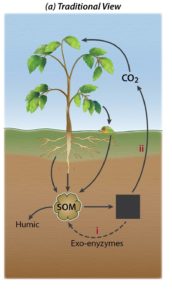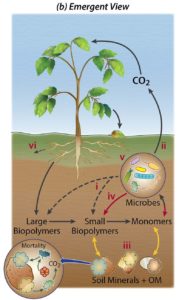
Traditional View: The traditional view of SOM decomposition does not explicitly represent the underlying agents and processes.

Emergent View: The emergent view suggests that SOM decomposition is a function of a wide range of ecosystem properties and mechanisms (e.g., organo-mineral interactions, microbial necromass).
While there currently exists a suite of models representing soil organic matter (SOM) dynamics that span a range of complexity, some recent mechanistic models are more consistent with an emerging understanding of the persistence of SOM. Yet even these more recent models do not represent several processes that can be important for SOM dynamics. It is clear that next-generation models need to represent the full spectrum of quantitatively important mechanisms for determining SOM persistence—including rate-limited and equilibrium-based sorption, formation of soil aggregates, representative soil minerals, microbial community dynamics, and vegetation interactions—to accurately predict short- and long-term SOM dynamics.
This study informs development of a robust predictive understanding of SOM dynamics. However, it is challenging to incorporate recommendations, such as mineral-associated organic matter and vegetation dynamics, in a reactive transport modeling framework. These emergent concepts require emergent technologies to appropriately characterize, e.g., molecular, soil, and root structure. Several technologies (e.g., FT-ICR-MS, NMR, STXM, and NEXAFS) are available today for such characterization, but these technologies have not yet been fully exploited nor have the resulting data/findings been fully incorporated into modeling studies. To enhance process understanding of SOM dynamics, streamlined coordination between technologies for characterization and emerging understanding for SOM modeling are needed.
Summary
Soils represent the largest store of actively cycling terrestrial organic carbon. This carbon is susceptible to release to the atmosphere as greenhouse gases, including carbon dioxide (CO2) and methane (CH4). However, significant gaps remain in understanding why certain soil organic matter (SOM) decomposes rapidly, and why thermodynamically unstable SOM can persist in soils for centuries. To fill this critical knowledge gap, a robust predictive understanding of SOM dynamics is essential, particularly for examining short-term and long-term changes in soil carbon storage and its feedback to climate. In this review paper, the authors argue that a representation of organic matter molecular structure, the activity of belowground communities, and mineral-associated organic matter (MAOM) are required to model SOM dynamics beyond first-order effects accurately. This argument is based on a review of the literature describing the current understanding of the main interacting biological, geochemical, and physical factors leading to SOM stabilization, and on an analysis of a suite of soil carbon models. The authors conclude by recommending several mechanisms that require implementation within the next generation of mechanistic models, including kinetic and equilibrium-based sorption, soil mineral surface chemistry, and vegetation dynamics to accurately predict short- and long-term SOM dynamics.
Citation
Dwivedi D, Tang J, Bouskill N, Georgiou K, Chacon SS, Riley WJ (2019) Abiotic and biotic controls on soil organomineral interactions: Developing model structures to analyze why soil organic matter persists. Rev Mineral Geochem 85:329–348; doi: 10.2138/rmg.2019.85.11
